VOLVO XC90 2014 Owner´s Manual
Manufacturer: VOLVO, Model Year: 2014, Model line: XC90, Model: VOLVO XC90 2014Pages: 308, PDF Size: 13.31 MB
Page 181 of 308
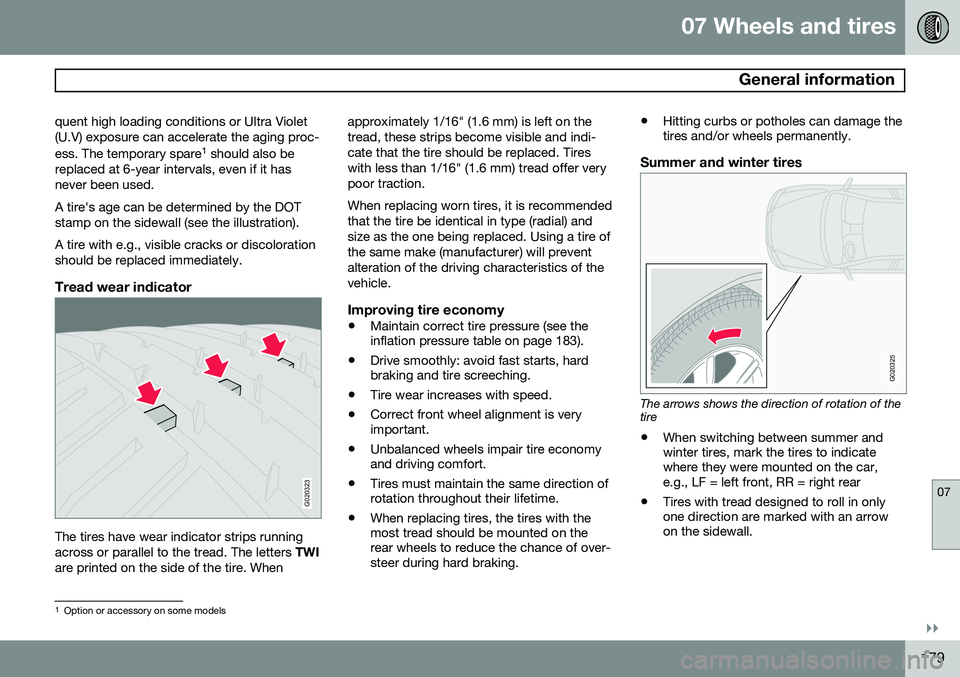
07 Wheels and tires
General information
07
}}
179
quent high loading conditions or Ultra Violet (U.V) exposure can accelerate the aging proc- ess. The temporary spare
1
should also be
replaced at 6-year intervals, even if it has never been used. A tire's age can be determined by the DOT stamp on the sidewall (see the illustration). A tire with e.g., visible cracks or discoloration should be replaced immediately.
Tread wear indicator
G020323
The tires have wear indicator strips running across or parallel to the tread. The letters TWI
are printed on the side of the tire. When approximately 1/16" (1.6 mm) is left on thetread, these strips become visible and indi-cate that the tire should be replaced. Tireswith less than 1/16" (1.6 mm) tread offer verypoor traction. When replacing worn tires, it is recommended that the tire be identical in type (radial) andsize as the one being replaced. Using a tire ofthe same make (manufacturer) will preventalteration of the driving characteristics of thevehicle.
Improving tire economy
•
Maintain correct tire pressure (see the inflation pressure table on page 183).
• Drive smoothly: avoid fast starts, hardbraking and tire screeching.
• Tire wear increases with speed.
• Correct front wheel alignment is veryimportant.
• Unbalanced wheels impair tire economyand driving comfort.
• Tires must maintain the same direction ofrotation throughout their lifetime.
• When replacing tires, the tires with themost tread should be mounted on therear wheels to reduce the chance of over-steer during hard braking. •
Hitting curbs or potholes can damage thetires and/or wheels permanently.
Summer and winter tires
G020325
The arrows shows the direction of rotation of the tire
• When switching between summer and winter tires, mark the tires to indicatewhere they were mounted on the car,e.g., LF = left front, RR = right rear
• Tires with tread designed to roll in onlyone direction are marked with an arrowon the sidewall.
1
Option or accessory on some models
Page 182 of 308
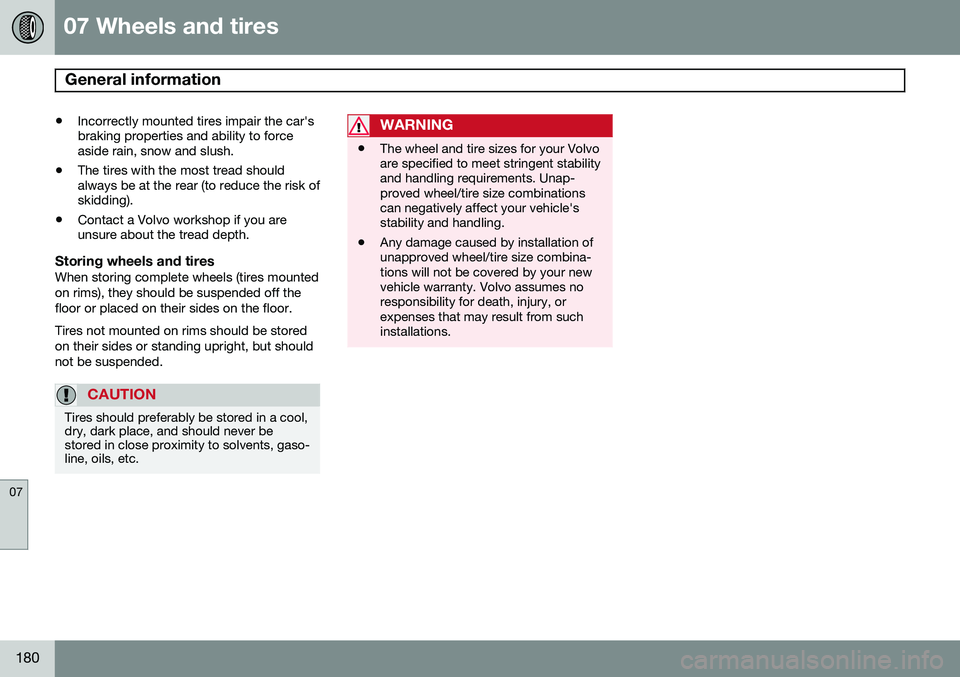
07 Wheels and tires
General information
07
180
•Incorrectly mounted tires impair the car's braking properties and ability to forceaside rain, snow and slush.
• The tires with the most tread shouldalways be at the rear (to reduce the risk ofskidding).
• Contact a Volvo workshop if you areunsure about the tread depth.
Storing wheels and tiresWhen storing complete wheels (tires mounted on rims), they should be suspended off thefloor or placed on their sides on the floor. Tires not mounted on rims should be stored on their sides or standing upright, but shouldnot be suspended.
CAUTION
Tires should preferably be stored in a cool, dry, dark place, and should never bestored in close proximity to solvents, gaso-line, oils, etc.
WARNING
•The wheel and tire sizes for your Volvo are specified to meet stringent stabilityand handling requirements. Unap-proved wheel/tire size combinationscan negatively affect your vehicle'sstability and handling.
• Any damage caused by installation ofunapproved wheel/tire size combina-tions will not be covered by your newvehicle warranty. Volvo assumes noresponsibility for death, injury, orexpenses that may result from suchinstallations.
Page 183 of 308
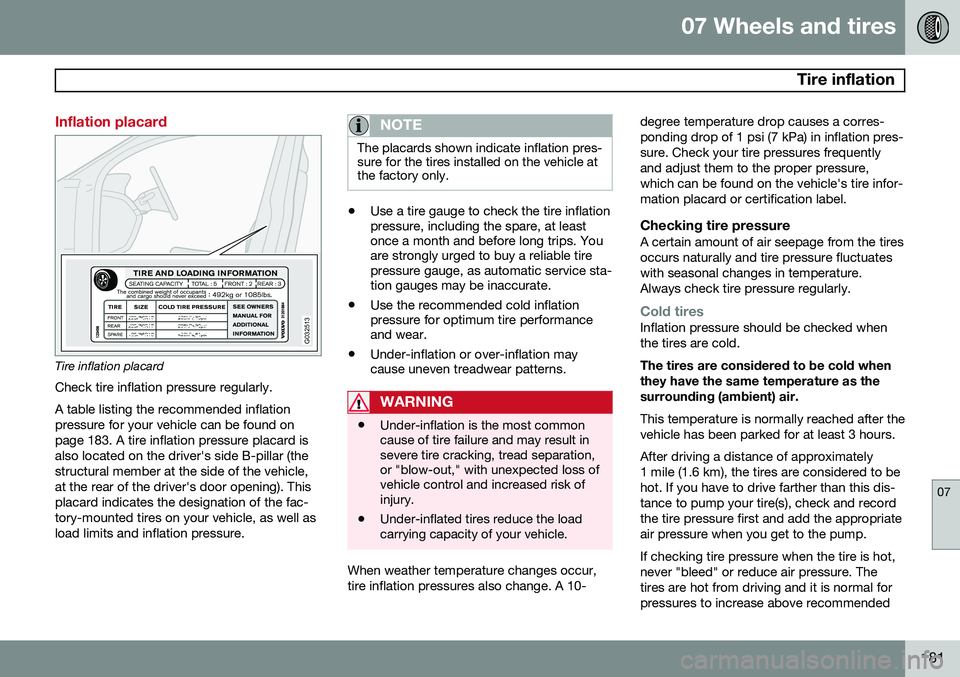
07 Wheels and tires
Tire inflation
07
181
Inflation placard
G032513
Tire inflation placardCheck tire inflation pressure regularly. A table listing the recommended inflation pressure for your vehicle can be found onpage 183. A tire inflation pressure placard isalso located on the driver's side B-pillar (thestructural member at the side of the vehicle,at the rear of the driver's door opening). Thisplacard indicates the designation of the fac-tory-mounted tires on your vehicle, as well asload limits and inflation pressure.
NOTE
The placards shown indicate inflation pres- sure for the tires installed on the vehicle atthe factory only.
• Use a tire gauge to check the tire inflation pressure, including the spare, at leastonce a month and before long trips. Youare strongly urged to buy a reliable tirepressure gauge, as automatic service sta-tion gauges may be inaccurate.
• Use the recommended cold inflationpressure for optimum tire performanceand wear.
• Under-inflation or over-inflation maycause uneven treadwear patterns.
WARNING
•Under-inflation is the most common cause of tire failure and may result insevere tire cracking, tread separation,or "blow-out," with unexpected loss ofvehicle control and increased risk ofinjury.
• Under-inflated tires reduce the loadcarrying capacity of your vehicle.
When weather temperature changes occur, tire inflation pressures also change. A 10- degree temperature drop causes a corres-ponding drop of 1 psi (7 kPa) in inflation pres-sure. Check your tire pressures frequentlyand adjust them to the proper pressure,which can be found on the vehicle's tire infor-mation placard or certification label.
Checking tire pressureA certain amount of air seepage from the tiresoccurs naturally and tire pressure fluctuateswith seasonal changes in temperature.Always check tire pressure regularly.
Cold tiresInflation pressure should be checked when the tires are cold. The tires are considered to be cold when they have the same temperature as thesurrounding (ambient) air. This temperature is normally reached after the vehicle has been parked for at least 3 hours. After driving a distance of approximately 1 mile (1.6 km), the tires are considered to behot. If you have to drive farther than this dis-tance to pump your tire(s), check and recordthe tire pressure first and add the appropriateair pressure when you get to the pump. If checking tire pressure when the tire is hot, never "bleed" or reduce air pressure. Thetires are hot from driving and it is normal forpressures to increase above recommended
Page 184 of 308
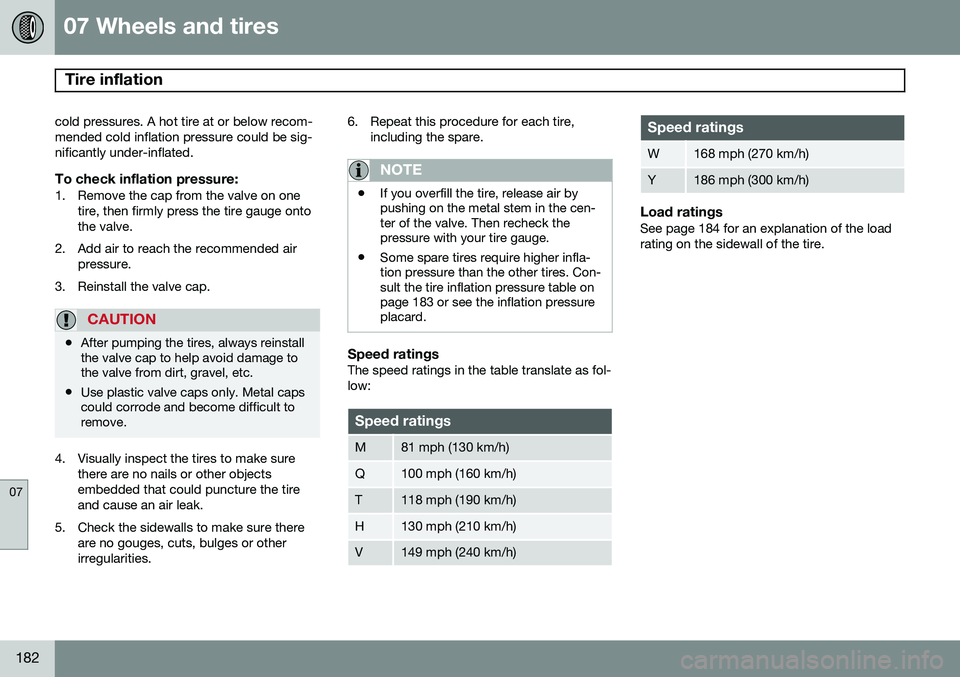
07 Wheels and tires
Tire inflation
07
182
cold pressures. A hot tire at or below recom- mended cold inflation pressure could be sig-nificantly under-inflated.
To check inflation pressure:1. Remove the cap from the valve on onetire, then firmly press the tire gauge ontothe valve.
2. Add air to reach the recommended air pressure.
3. Reinstall the valve cap.
CAUTION
• After pumping the tires, always reinstall the valve cap to help avoid damage tothe valve from dirt, gravel, etc.
• Use plastic valve caps only. Metal capscould corrode and become difficult toremove.
4. Visually inspect the tires to make sure
there are no nails or other objects embedded that could puncture the tireand cause an air leak.
5. Check the sidewalls to make sure there are no gouges, cuts, bulges or otherirregularities. 6. Repeat this procedure for each tire,
including the spare.
NOTE
•If you overfill the tire, release air by pushing on the metal stem in the cen-ter of the valve. Then recheck thepressure with your tire gauge.
• Some spare tires require higher infla-tion pressure than the other tires. Con-sult the tire inflation pressure table onpage 183 or see the inflation pressureplacard.
Speed ratingsThe speed ratings in the table translate as fol- low:
Speed ratings
M81 mph (130 km/h)
Q100 mph (160 km/h)
T118 mph (190 km/h)
H130 mph (210 km/h)
V149 mph (240 km/h)
Speed ratings
W168 mph (270 km/h)
Y186 mph (300 km/h)
Load ratingsSee page 184 for an explanation of the load rating on the sidewall of the tire.
Page 185 of 308

07 Wheels and tires
Tire inflation pressure table
07
183
The following tire pressures are recom- mended by Volvo for your vehicle. Refer to
the tire inflation placard (see page 181 for itslocation) for information specific to the tiresinstalled on your vehicle at the factory.
Tire sizeCold tire pressure up to five persons psi (kPa)
Front psi (kPa)Rear psi (kPa)
235/65 R17 235/60 R18255/50 R19255/45 R2036 (250)36 (250)
Temporary spare tire T125/80R1761 (420)61 (420)
NOTE
Please consult a Volvo retailer’s Parts department for the most up-to-date speci-fications.
Page 186 of 308

07 Wheels and tires
Tire designations
07
184
1
2
3
4
5
6
12
11
10
8
79
G026442
Federal law mandates that tire manufacturers place standardized information on the side-wall of all tires (see the illustration). The following information is listed on the tire sidewall: The tire designation:
NOTE
Please be aware that the following tire designation is an example only and that
this particular tire may not be available onyour vehicle.
215 : the width of the tire (in millimeters)
from sidewall edge to sidewall edge. The larger the number, the wider the tire.
65 : The ratio of the tire's height to its
width in percent.
R : Radial tire (the designation RF and the
symbol indicate that the vehicle is
equipped with optional self-supporting run flat tires 1
. See page 205 for more
information about these tires).
15 : The diameter of the wheel rim (in
inches).
95 : The tire's load index. In this example,
a load index of 95 equals a maximum load of 1521 lbs (690 kg).
H : The tire's speed rating, or the maxi-
mum speed at which the tire is designed to be driven for extended periods of time,carrying a permissible load for the vehi-cle, and with correct inflation pressure.For example, H indicates a speed ratingof 130 mph (210 km/h).
NOTE
The tire's load index and speed rating may not appear on the sidewall because theyare not required by law.
M+S or M/S = Mud and Snow; AT = All
Terrain; AS = All Season
U.S. DOT Tire Identification Number (TIN): This begins with the letters "DOT"
and indicates that the tire meets all fed- eral standards. The next two numbers orletters are the plant code where it wasmanufactured, the next two are the tiresize code and the last four numbers rep-resent the week and year the tire wasbuilt. For example, 1510 means that thetire was manufactured during week 15 of2010. The numbers in between are mar-keting codes used at the manufacturer'sdiscretion. This information helps a tiremanufacturer identify a tire for safetyrecall purposes.
Tire Ply Composition and Material Used: Indicates the number of plies indi-
cates or the number of layers of rubber- coated fabric in the tire tread and side-wall. Tire manufacturers also must indi-cate the ply materials in the tire and thesidewall, which include steel, nylon, poly-ester, and others.
1 Self-supporting run flat tires may not be available on all models
Page 187 of 308
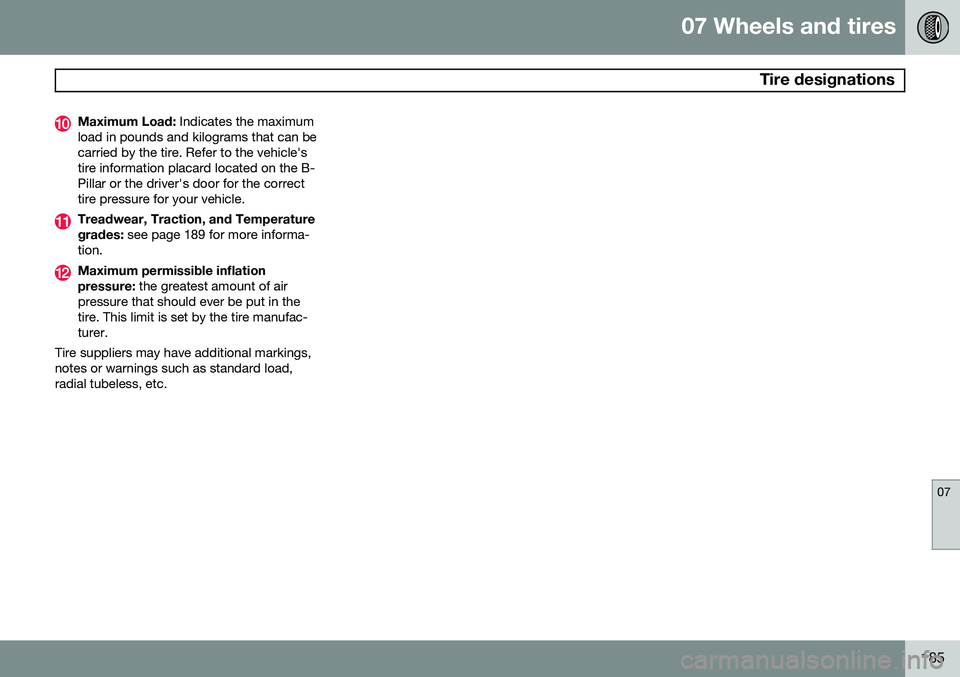
07 Wheels and tires
Tire designations
07
185
Maximum Load: Indicates the maximum
load in pounds and kilograms that can be carried by the tire. Refer to the vehicle'stire information placard located on the B-Pillar or the driver's door for the correcttire pressure for your vehicle.
Treadwear, Traction, and Temperature grades: see page 189 for more informa-
tion.
Maximum permissible inflation pressure: the greatest amount of air
pressure that should ever be put in the tire. This limit is set by the tire manufac-turer.
Tire suppliers may have additional markings,notes or warnings such as standard load,radial tubeless, etc.
Page 188 of 308
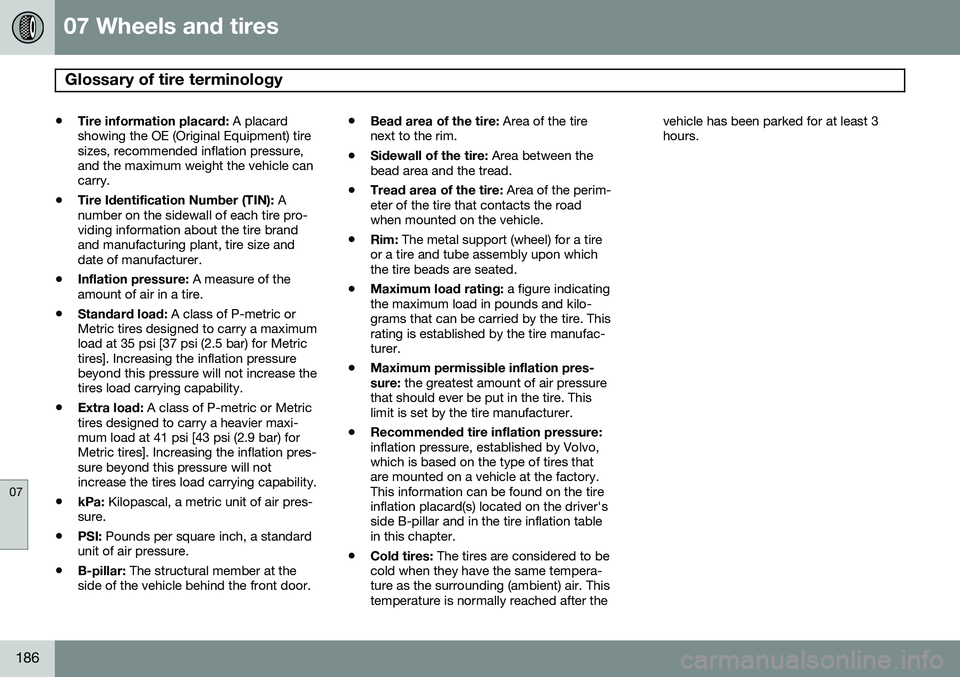
07 Wheels and tires
Glossary of tire terminology
07
186
•Tire information placard:
A placard
showing the OE (Original Equipment) tire sizes, recommended inflation pressure,and the maximum weight the vehicle cancarry.
• Tire Identification Number (TIN):
A
number on the sidewall of each tire pro-viding information about the tire brandand manufacturing plant, tire size anddate of manufacturer.
• Inflation pressure:
A measure of the
amount of air in a tire.
• Standard load:
A class of P-metric or
Metric tires designed to carry a maximumload at 35 psi [37 psi (2.5 bar) for Metrictires]. Increasing the inflation pressurebeyond this pressure will not increase thetires load carrying capability.
• Extra load:
A class of P-metric or Metric
tires designed to carry a heavier maxi-mum load at 41 psi [43 psi (2.9 bar) forMetric tires]. Increasing the inflation pres-sure beyond this pressure will notincrease the tires load carrying capability.
• kPa:
Kilopascal, a metric unit of air pres-
sure.
• PSI:
Pounds per square inch, a standard
unit of air pressure.
• B-pillar:
The structural member at the
side of the vehicle behind the front door. •
Bead area of the tire:
Area of the tire
next to the rim.
• Sidewall of the tire:
Area between the
bead area and the tread.
• Tread area of the tire:
Area of the perim-
eter of the tire that contacts the roadwhen mounted on the vehicle.
• Rim:
The metal support (wheel) for a tire
or a tire and tube assembly upon whichthe tire beads are seated.
• Maximum load rating:
a figure indicating
the maximum load in pounds and kilo-grams that can be carried by the tire. Thisrating is established by the tire manufac-turer.
• Maximum permissible inflation pres- sure:
the greatest amount of air pressure
that should ever be put in the tire. This limit is set by the tire manufacturer.
• Recommended tire inflation pressure: inflation pressure, established by Volvo, which is based on the type of tires thatare mounted on a vehicle at the factory.This information can be found on the tireinflation placard(s) located on the driver'sside B-pillar and in the tire inflation tablein this chapter.
• Cold tires:
The tires are considered to be
cold when they have the same tempera-ture as the surrounding (ambient) air. Thistemperature is normally reached after the vehicle has been parked for at least 3hours.
Page 189 of 308
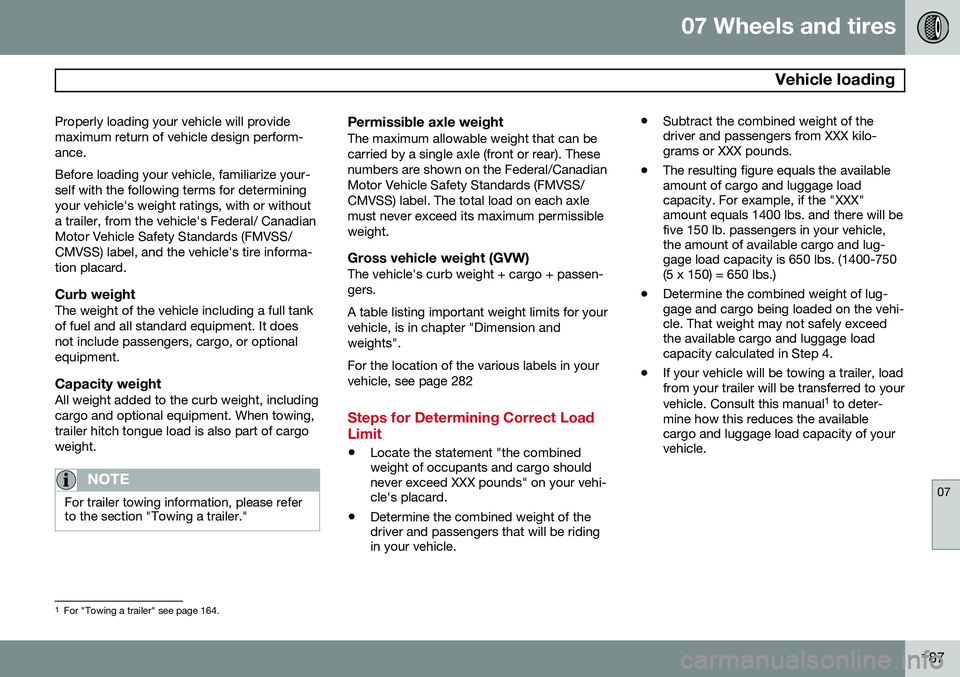
07 Wheels and tires
Vehicle loading
07
187
Properly loading your vehicle will provide maximum return of vehicle design perform-ance. Before loading your vehicle, familiarize your- self with the following terms for determiningyour vehicle's weight ratings, with or withouta trailer, from the vehicle's Federal/ CanadianMotor Vehicle Safety Standards (FMVSS/CMVSS) label, and the vehicle's tire informa-tion placard.
Curb weightThe weight of the vehicle including a full tankof fuel and all standard equipment. It doesnot include passengers, cargo, or optionalequipment.
Capacity weightAll weight added to the curb weight, includingcargo and optional equipment. When towing,trailer hitch tongue load is also part of cargoweight.
NOTE
For trailer towing information, please refer to the section "Towing a trailer."
Permissible axle weightThe maximum allowable weight that can be carried by a single axle (front or rear). Thesenumbers are shown on the Federal/CanadianMotor Vehicle Safety Standards (FMVSS/CMVSS) label. The total load on each axlemust never exceed its maximum permissibleweight.
Gross vehicle weight (GVW)The vehicle's curb weight + cargo + passen-gers. A table listing important weight limits for your vehicle, is in chapter "Dimension andweights". For the location of the various labels in your vehicle, see page 282
Steps for Determining Correct Load Limit
•
Locate the statement "the combined weight of occupants and cargo shouldnever exceed XXX pounds" on your vehi-cle's placard.
• Determine the combined weight of thedriver and passengers that will be ridingin your vehicle. •
Subtract the combined weight of thedriver and passengers from XXX kilo-grams or XXX pounds.
• The resulting figure equals the availableamount of cargo and luggage loadcapacity. For example, if the "XXX"amount equals 1400 lbs. and there will befive 150 lb. passengers in your vehicle,the amount of available cargo and lug-gage load capacity is 650 lbs. (1400-750(5 x 150) = 650 lbs.)
• Determine the combined weight of lug-gage and cargo being loaded on the vehi-cle. That weight may not safely exceedthe available cargo and luggage loadcapacity calculated in Step 4.
• If your vehicle will be towing a trailer, loadfrom your trailer will be transferred to your vehicle. Consult this manual 1
to deter-
mine how this reduces the available cargo and luggage load capacity of yourvehicle.
1 For "Towing a trailer" see page 164.
Page 190 of 308
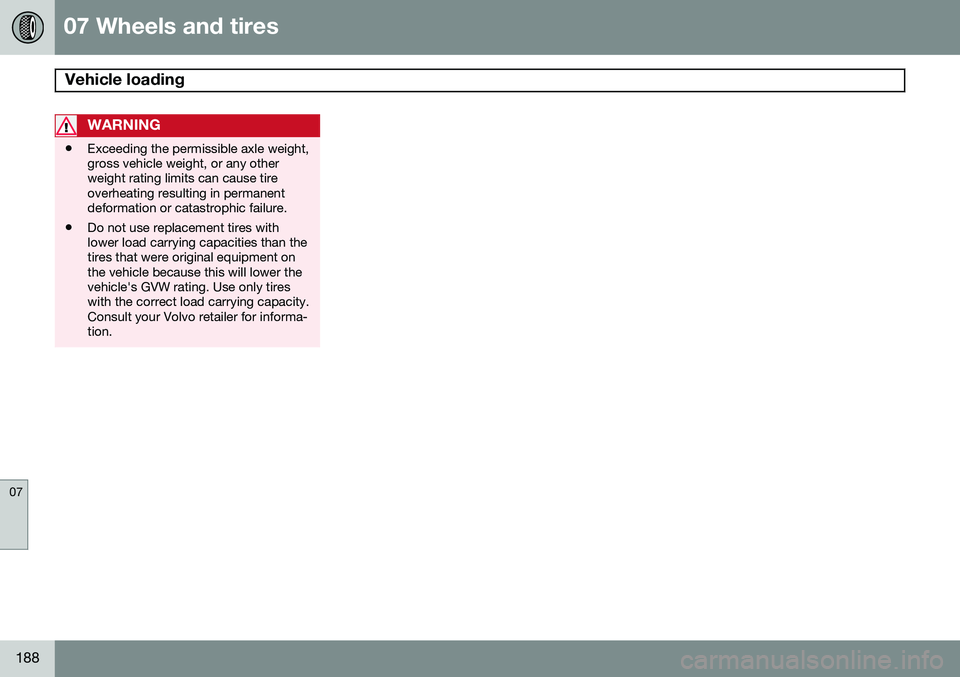
07 Wheels and tires
Vehicle loading
07
188
WARNING
•Exceeding the permissible axle weight, gross vehicle weight, or any otherweight rating limits can cause tireoverheating resulting in permanentdeformation or catastrophic failure.
• Do not use replacement tires withlower load carrying capacities than thetires that were original equipment onthe vehicle because this will lower thevehicle's GVW rating. Use only tireswith the correct load carrying capacity.Consult your Volvo retailer for informa-tion.